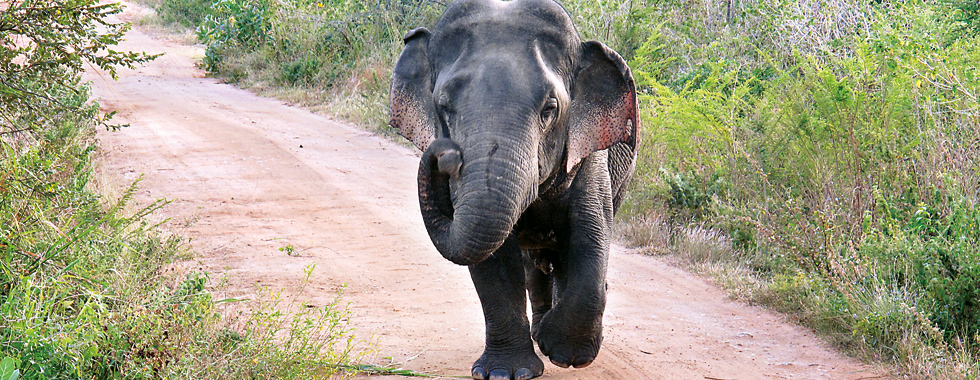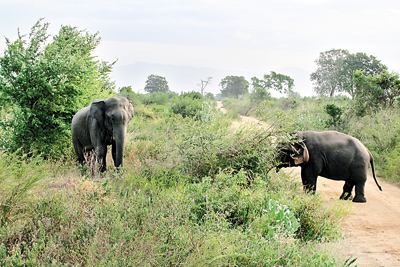Look at that little fella!
Unique it was and a sight never beheld in the wilds of Sri Lanka or anywhere else in the world for that matter.
A dwarf elephant!
It was 6.30 in the morning on July 7 and for environmentalist Rohan Wijesinha the foray into the Uda Walawe National Park was like the hundreds he had undertaken in the past 20 years.

Loner in the wilds: Beating all odds the dwarf elephant has grown into adulthood. Pix by Brad Abbott
In the distance, Rohan who was accompanied by tracker Saman, wildlife enthusiast Vernon Tissera and friend Brad Abbott, saw not an unusual scene. There was a face-off between two elephants. They could see one elephant, a young bull, quite well. The other in the squaring-off they thought they saw was a baby elephant.
“Although he seemed strong, he was small,” says Rohan, explaining that he was masked by a bush. The excitement mounted when the aggressive “little fellow” turned and strode towards the jeep, as bemused tracker Saman exclaimed: “Amuthu aliyek.” (A strange elephant.)
Coming right up to them was an elephant whose upper body was perfectly normally developed but the lower half was stunted. Incredible it was, says Rohan, who points out that though it is difficult to “fix” the age of an elephant without looking at its teeth, they could see that he was between 20-30 years. He was also in musth.
How had this dwarf elephant escaped attention, the group wondered, with tracker Saman quite certain that no one had “ever seen this chap before”, says Rohan, conjecturing whether even if seen in the distance he may have been mistaken for a baby or on hearing humans he may have disappeared into the scrub jungle and not been seen as he was so very short. As he came very close to the jeep, they could estimate his height to be about 5’ against the vehicle, says this environmentalist, adding that it is a tribute to elephants — both his devoted mother and his herd — that he has survived.

Rohan Wijesinha
Having been spotted a few more times, he seems to have left the Uda Walawe National Park, to go a-roaming. For Rohan and his group who had the rare privilege of being “absolutely astounded” by seeing this assertive and determined dwarf elephant, many were the interesting topics that spiced up their conversations……not only the mundane about how he would forage for food but also how he would seek fulfilment for his reproductive urges, with the verdict being that it would be a sadly frustrated elephant, for no fault of his.
When Rohan uploaded the dwarf elephant’s photographs on Facebook, many had also been the derisive comments from disbelieving friends that he had become “a Photoshop expert”.
Numerous elephants though he may have seen, this is the beauty of the wilds of Sri Lanka, smiles Rohan, for you don’t know what “wonderful things” it will put on your path next.
Gajah’s pin-up jumbo
This nature’s wonder is unquestionably ‘cover’ material. With his mature adult face but short legs, his strange but heart-warming photograph adorns the glossy cover of the latest issue of ‘Gajah’, the Journal of the Asian Elephant Specialist Group, hot off the presses this week. The photo has been captured by Brad Abbott.
‘Gajah’ reports the sighting at the Uda Walawe National Park as the first record of a free ranging adult wild animal – an Asian elephant (Elephas maximus), with disproportionate dwarfism. A ‘Short Communication’ titled ‘Disproportionate Dwarfism in a Wild Asian Elephant’ in ‘Gajah’ states: “It had a normal sized upper body, with well-developed male secondary sexual characteristics such as a large head, broad trunk-base, pronounced nasal bump and prominent temporal protuberances but had very short, stubby legs. The other elephant was of normal stature.”
Both displayed temporal gland secretions indicative of ‘musth’ – an annual physiological state in male elephants with heightened aggression and increased ranging behaviour. The ‘dwarf’ was by far the main aggressor in the altercation and appeared to be older than the other, a young-adult, it states.
The authors of this piece are Rohan Wijesinha of the Federation of Environmental Organizations; Nadika Hapuarachchi of the Wildlife Conservation Society of Galle; Brad Abbott; and Jennifer Pastorini of the Centre for Conservation and Research (CCR) and Anthropologisches Institut, Universitat Zurich, Switzerland, while Prithiviraj Fernando of the CCR is the corresponding author. Nadika had also been at the spot but in another vehicle when the dwarf was sighted by Rohan.
“Other than for the disproportionately short legs, morphologically and behaviourally the dwarf elephant appeared normal. Absence of previous records and body lumps from gunshot injuries indicative of crop raiding outside the park, suggest that he was not a resident but wandered into the park during musth ranging,” states the article.

The face-off at Uda Walawe
CCR’s Dr. Prithiviraj Fernando told the Sunday Times that this is the only scientifically proven dwarf elephant in the wild, although dwarfism is not uncommon among humans. Pointing out that among domestic animals there has been breeding of dwarf phenotypes, he cited the examples of dogs such as the dachshund, basset hound and bull dog, cats such as the munchkin, Japanese brown and Dexter cattle, Ethiopian dwarf goats and Vietnamese pot bellied pigs. (Phenotypes are the observable physical or biochemical characteristics of an organism, as determined by both genetic makeup and environmental influences.)
Dwarfism in humans is most commonly caused by a genetic condition known as achondroplasia – a deficiency in cartilage where the long bones don’t grow properly, said Dr. Fernando. While people are attracted to the unique appearance caused by this mutation and breed such domestic animals, this is rare in the wild because it is a disadvantage, it is learnt.
In the wild, an animal is either a predator or prey. With such a mutation, a predator would be at a disadvantage in catching prey, whereas prey with such a mutation would fall victim very easily to a predator. With survival of the fittest being the law of the jungle, a wild animal with such a mutation would die quickly, says Dr. Fernando.
However, according to this expert, the exception to this rule is the Asian elephant in Sri Lanka. They are unique because they are mega herbivores and are neither predators nor prey. This is especially so in Sri Lanka because we don’t have tigers or lions which in other countries may take an elephant calf.
The dwarf sighted at Uda Walawe would have faced the challenge of suckling from his mother when he was a baby, he points out, adding that he has beaten the odds and survived. Referring to the gunshot wounds this survivor has suffered and the fact that he has never been seen at the Uda Walawe National Park before, though it has been the focus of intensive elephant research, Dr. Fernando says that obviously the dwarf lives outside this Protected Area (PA).
The important lesson here is that it is vital to have PAs and areas not demarcated as PAs as one management unit, so that unique animals such as the dwarf and not-so-unique elephants, all of whom are vital for Sri Lanka’s vibrant ecosystem, could roam freely, he adds.
(‘Gajah’ may be accessed on: www.asesg.org/gajah.htm or a hard copy obtained by e-mailing: romalijj@eureka.lk or writing to Jayantha Jayewardene, 615/32, Rajagiriya Gardens, Nawala Road, Rajagiriya)



